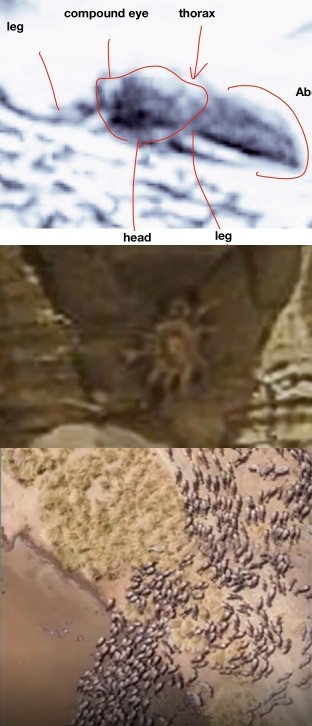
Top Romoser's insect-like photo, captioned “Whole insect-like body head turned toward camera.”
Middle Earlier photo taken by NASA's Mars Curiosity Rover of a rock formation resembling a crab. This is an authentic photo, available as a JPEG at jpl.nasa.gov.
Bottom Photo supposedly taken from Mars orbiter resembling a herd of animals. It is said that NASA says these are sand dunes covered in subliming seasonal frost in Spring. This image is from a still image posted to YouTube.
 ars is crawling with bugs, declares
Dr
William S Romoser, an entomology professor emeritus from Ohio University in
Athens, Ohio. Romoser, who has studied bugs for 45 years, is the author of The
Science of Entomology, so his claim has gotten a little attention and a lot of
skepticism. He's quoted as saying:
ars is crawling with bugs, declares
Dr
William S Romoser, an entomology professor emeritus from Ohio University in
Athens, Ohio. Romoser, who has studied bugs for 45 years, is the author of The
Science of Entomology, so his claim has gotten a little attention and a lot of
skepticism. He's quoted as saying:
The presence of higher metazoan organisms on Mars implies the presence of nutrient/energy sources and processes, food chains and webs, and water as elements functioning in a viable, if extreme, ecological setting sufficient to sustain life.
He claims to believe the insects resemble the bumble bees or carpenter bees on Earth.
I suspect the good doctor is just pulling our tentacles. Or maybe it's another NASA publicity stunt to gin up excitement for their Mars 2020 Rover, scheduled for launch in July 2020.
If he's right, Mars 2020 may need a special mechanism to scrape all the dead carpenter bees off its front grille as it speeds across the parched Martian desert in a scene reminiscent of the movie Prometheus. And just like in the movie, NASA hopes to bring back a sample.
The professor isn't the first to see animals in the Mars images. Everything on Mars resembles some kind of animal. Some of NASA's photos resemble herds of buffalo or giant crabs. Then there was the famous “bunny rabbit” that turned out to be a piece of debris from the lander.
NASA consistently waves the images away, saying (in effect): “These aren't the animals you're looking for. Move along.”
The difficulty is that the public images are mostly JPEGs, which aren't amenable to image analysis, and the lack of metadata makes it impossible to tell the size. Are those ‘buffalo’ five feet or twenty-five miles long? Without knowing the distance and magnification, that stegosaurus and bigfoot in the background could be three inches high or two miles high. This is why including an identifiable size referent in our Earth photos, like a person or a junked car, is so effective in conveying the magnificence of a natural scene. We can guess the Mars 2020 Rover is seven feet tall and not 2½ inches tall by assuming the wheels are the same size as on a car. But a Mars landscape is too unfamiliar.
Size is important; if Romoser's ‘carpenter bee’ is seven feet long, it's improbable, especially in Mars's thin atmosphere. NASA only has itself to blame for all the conspiracy theories.
Perhaps the strangest claim is from a guy named Joseph McMoneagle who claimed to have used remote viewing while at the CIA to observe a colony of living beings on Mars living approximately 1 million years in the past. These beings were said to be in hibernation, hoping to find a new planet to move to, as their civilization was in a critical state.
And no wonder: carpenter bees can be a real nuisance. They drill holes in wooden structures and lay their eggs. They cause millions of dollars in damage every year by tunneling into decks, wood siding, and porches. Of course, the damage is mitigated somewhat by the fact that there is, as far as anyone knows, no wood on Mars.
At least now we have a theory as to why.
nov 21 2019, 4:33 am
